Historical models

ThinkPad 235edit
The Japan-only ThinkPad 235 (or Type 2607) was the progeny of the IBM/Ricoh RIOS project. Also known as Clavius or Chandra2, it contains unusual features like the presence of three PCMCIA slots and the use of dual camcorder batteries as a source of power. Features an Intel Pentium MMX 233 MHz CPU, support for up to 160 MB of EDO memory, and a built-in 2.5 in (64 mm) hard drive with UDMA support. Hitachi marketed Chandra2 as the Prius Note 210.
ThinkPad 240edit
The ultraportable ThinkPad 240 (X, Z) started with an Intel Celeron processor and went up to the 600 MHz Intel Pentium III. In models using the Intel 440BX chipset, the RAM was expandable to 320 MB max with a BIOS update. Models had a 10.4 in (260 mm) screen and an 18 mm (0.71 in) key pitch (a standard key pitch is 19 mm (0.75 in)). They were also one of the first ThinkPad series to contain a built-in Mini PCI card slot (form factor 3b). The 240s have no optical disc drives and an external floppy drive. An optional extended battery sticks out the bottom like a bar and props up the back of the laptop. Weighing in at 2.9 lb (1.3 kg), these were the smallest and lightest ThinkPads ever made.
300 Seriesedit
The 300-series (300, 310, 340, 345, 350, 360, 365, 380, 370, 385, 390 (all with various sub-series)) was a long-running value series starting at the 386SL/25 processor, all the way to the Pentium III 450. The 300 series was offered as a slightly lower-price alternative from the 700 series, with a few exceptions.
The ThinkPad 360PE was a unique model in the series in that it could be used as a regular laptop, or transform into a tablet by flipping the monitor on top of itself. Retailing for $3,699 in 1995, the 360PE featured a touch sensitive monitor that operated with the stylus; the machine could run operating systems that supported the touch screen such as PenDOS 2.2.
An IBM ThinkPad 310ED and a 760ED, both from the 1996–97 era. The 760ED boasts the unique flip-up keyboard that was standard on all 760 ThinkPads
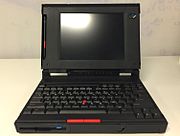
The 360PE opened in its 'natural' mode
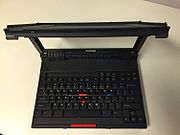
The 360PE in mid-fold showing how the monitor rotates over the unit

The 360PE folded in its 'tablet' mode allowing the laptop to be held as a tablet would

The 360PE's keyboard opens up on hinges for easy serviceability
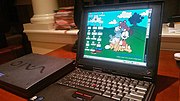
An IBM ThinkPad 390 running Windows 98 SE
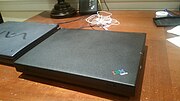
An IBM ThinkPad 390 with the lid closed
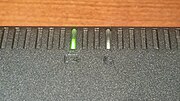
IBM ThinkPad 390 charging/standby indication lights

Back view of an IBM ThinkPad 390, showing the PS/2, DB15, DB9, VGA and charger ports

IBM ThinkPad 365XD w/External Floppy Drive running Windows 95B,
500 Seriesedit
The 500-series (500, 510, 560 (E, X, Z), 570 (E)) were the main line of the ultraportable ThinkPads. Starting with the 486SLC2-50 Blue Lightning to the Pentium III 500, these machines had only a hard disk on board. Any other drives were external (or in the 570's case in the UltraBase). They weighed in at around 4 lb (1.8 kg).
600 Seriesedit
The 600-series (600, 600E, and 600X) are the direct predecessors of the T series. The 600-series packed a 12.1 in (310 mm) SVGA or a 13.3 in (340 mm) XGA TFT LCD, Pentium MMX, Pentium II or III processor, full-sized keyboard, and optical bay into a package weighing roughly 5 lb (2.3 kg). IBM was able to create this light, fully featured machine by using lightweight but strong carbon fiber composite plastics. The battery shipped with some 600-series models had a manufacturing defect that left it vulnerable to memory effect and resulted in poor battery life, but this problem can be avoided by use of a third-party battery.
700 Seriesedit
| External image | |
|---|---|
This was the first successful ThinkPad introduced in 1992 (the first ThinkPad was a tablet PC 700T model without a keyboard and a mouse).
800 Seriesedit
The ThinkPad 800-Series (800/820/821/822/823/850/851/860) were unique as they were based on the PowerPC architecture rather than the Intel x86 architecture. Most of the 800 Series laptops used the PowerPC 603e CPU, at speeds of 100 MHz, or 166 MHz in the 860 model, although the earliest 800 (Type 6020), the direct ancestor of the 850, used a 603 and was apparently only offered to developers. All units used SCSI-2 instead of IDE hard disks, and the ID of every SCSI device on the system could be configured in the cursor driven GUI-based BIOS. Another unusual aspect of the series is their unique startup chime, reminiscent of Apple Macintosh computers of the time.
The PowerPC ThinkPad line was considerably more expensive than the standard x86 ThinkPads—even a modestly configured 850 cost upwards of $12,000. On the other hand, the 800, 850 and 851 (and later the 860 and 861) were capable of supporting an optional web camera, one of the first commercially available webcams available on a laptop. These units could also record PAL and NTSC signals with onboard composite connectors, and the batteries contained internal processors to regulate power usage for optimized battery longevity.
All of the PowerPC ThinkPads could run Windows NT 3.5 and 4.0, OS/2 Warp Connect PowerPC Edition, AIX 4.1.x, and Solaris Desktop 2.5.1 PowerPC Edition. Many of these PowerPC operating systems and the corresponding compilers are very scarce and hard to find. However, it is also possible to run certain PowerPC versions of Linux on the 800 Series.
| 800 | 820 | 821/822/823 | 850 | 851 | 860 | |
|---|---|---|---|---|---|---|
| System Type | 6020 | 6040 | 7247 | 6042 | 7249 | 7249 |
| Announced | 1994/08/11 | 1995/06/19 | 1996/02/20 | 1995/06/19 | 1996/02/20 | 1996/10/08 |
| Withdrawn | Unknown | 1996/03/20 | 1996/07/26 | 1996/03/20 | 1996/11/08 | 1998/01/30 |
| CPU | 603 @ 66 MHz | 603e @ 100 MHz | 603e @ 100 MHz | 603e @ 100 MHz | 603e @ 100 MHz | 603e @ 166 MHz |
| GPU | GT10 | GT10 | GT10 | GT10 | GT10 | GT20 |
| Memory Bus | 32 bit | 32 bit | 32 bit | 64 bit | 64 bit | 64 bit |
| Maximum Memory | 80 MB | 48 MB | 48 MB | 96 MB | 96 MB | 96 MB |
| Display | 10.4" 640 × 480 | 10.4" 640 × 480 or 800 × 600 | 10.4" 640 × 480 or 800 × 600 | 10.4" 640 × 480 or 800 × 600 | 10.4" 640 × 480 or 800 × 600 | 12.1" 1024 × 768 |
| Video Capture | built-in | optional | optional | built-in | built-in | built-in |

An IBM ThinkPad 850 with its custom IBM-branded Logitech Chroma mouse

The PowerPC ThinkPad logo as found on the 850 carrying case; similar to Lenovo's redesigned logo with the red dotted i
WorkPadedit
Based on ThinkPad design although branded WorkPad, the IBM WorkPad z50 was a Handheld PC running Windows CE, released in 1999.
i Series (1998–2002)edit
| ThinkPad i series 1998-2001 | ||||||||||||||||
|---|---|---|---|---|---|---|---|---|---|---|---|---|---|---|---|---|
| 1998 | 1999 | 2000 | 2001 | |||||||||||||
| 15.0" | I1492 | i1592 | ||||||||||||||
| 14.1" | I1560 | I1483 | ||||||||||||||
| i1472 | i1721 | i1480 | I1482 | |||||||||||||
| i1452 | i1552 | i1400 | i1460 | I1562 | i1800 | |||||||||||
| 13.3" | i1157 | |||||||||||||||
| i1450 | i1451 | i1720 | I1260 | I1370 | I1200 | i1300 | ||||||||||
| 13.0" | i1400 | i1420 | I1421 | I1422 | I1230 | |||||||||||
| 12.1" | i1410 | i1411 | i1412 | i1512 | i1540 | I1541 | I1442 | I1542 | I1210 | I1330 | I1200 | i1300 | ||||
| I1620 | I1250 | |||||||||||||||
| 12.0" | I1441 | |||||||||||||||
| 10.4" | i1124 | S30 | S31 | |||||||||||||
The ThinkPad i Series was introduced by IBM in 1999 and was geared towards a multimedia focus with many models featuring independent integrated CD players and multimedia access buttons. The 1400 and 1500 models were designed by Acer for IBM under contract and featured similar hardware found in Acer laptops (including ALi chipsets, three way audio jacks and the internal plastics painted with a copper paint). Some of the i Series ThinkPads, particularly the Acer developed models, are prone to broken hinges and stress damage on the chassis.citation needed
One notable ThinkPad in the i Series lineup are the S3x (S30/S31) models: featuring a unique keyboard and lid design allowing a standard size keyboard to fit in a chassis that otherwise wouldn't be able to support the protruding keyboard. These models were largely only available in Asia Pacific. IBM offered an optional piano black lid on these models (designed by the Yamato Design lab). This is the only ThinkPad since the 701C to feature a special design to accommodate a keyboard that's physically larger than the laptop and also the only ThinkPad (aside from the Z61) to deviate away from the standard matte lid.citation needed
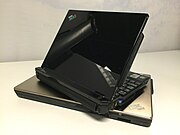
The ThinkPad S31 with the piano black finish option sitting on top of a Z61t; both ThinkPads deviate from the usual matte black.

The S31 with the lid open showing the unique protruding keyboard; no touchpad was offered, to keep the laptop compact.
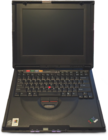
An IBM ThinkPad 1400 i Series with the integrated CD-Player and customizable multimedia access buttons
A Series (2000–2004)edit
| IBM ThinkPad A 2000-2004 | |||||||
|---|---|---|---|---|---|---|---|
| case | screen | A2* | A3* | ||||
| 14" | 12" | Low-cost | A20m | A21m | A22m | ||
| 13" | A22e | ||||||
| 14" | |||||||
| Standard |
A20m | A21m | A22m | A30 | A31 | ||
| 15" | 15" | ||||||
| Performance | A20p | A21p | A22p | A30p | A31p | ||
The A-series was developed as an all-around productivity machine, equipped with hardware powerful enough to make it a desktop replacement. Hence it was the biggest and heaviest ThinkPad series of its time, but also had features not even found in a T-series of the same age. The A-series was dropped in favor of the G-series and R-series.
The A31 was released in 2002 as a desktop replacement system equipped with: A Pentium 4-M processor clocked at 1.6, 1.8, 1.9, or 2.0 GHz (max supported is a 2.6 GHz), An ATI Mobility Radeon 7500, 128 or 256 MB of PC2100 RAM (officially upgradable to 1 GB but can be unofficially upgraded to 2 GB), IBM High Rate Wireless (PRISM 2.5 Based, can be modified to support WPA-TKIP) and equipped with a 20, 30, or 40 GB hard disk drive.
R Series (2001–2010, 2018-2019)edit
The R Series was a budget line, beginning with the R30 in 2001 and ending with the R400 and R500 presented in 2008.
The successor of a R400 and R500 models is a ThinkPad L series L412 and L512 models.
A notable model is the R50p with an optional 15" 2048 × 1536 IPS LCD screen (introduced in 2003).
| ThinkPad R 2001-2010 | ||||||||||||
|---|---|---|---|---|---|---|---|---|---|---|---|---|
| R3* | R4* | R5* | R6* | R*00 | ||||||||
| case | screen | 3:4 screens | ||||||||||
| 14" | 13" | Low-cost | R40e | |||||||||
| Standard | R30 | R31 | R40 | |||||||||
| 14" | Low-cost | R40e | R50e | R51e | ||||||||
| Standard | R30 | R31 | R32 | R40 | R50 | R51 | R52 | R60 | ||||
| 15" | Low-cost | R50e | R51e | R60e | ||||||||
| R61i | ||||||||||||
| Standard | R40 | R50 | R51 | R52 | R60 | R61 | ||||||
| Performance | R50p | |||||||||||
| 16:10 screens | ||||||||||||
| 14,1" | Standard | R61 | R400 | |||||||||
| 15,4" | Low-cost | R61i | ||||||||||
| R61e | ||||||||||||
| Standard | R61 | R500 | ||||||||||

Lenovo ThinkPad R500
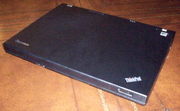
Lenovo ThinkPad R500 (lid closed)

IBM ThinkPad R51

IBM ThinkPad R32
The R series reintroduced in 2018 (for Chinese market only) with the same hardware as E series models, but with aluminum display cover, discrete GPU, TPM chip and fingerprint reader.
G Series (2003–2006)edit
The G-series consisted of only three models, the G40, G41 and G50. Being large and heavy machines, equipped with powerful desktop processors, this line of ThinkPads consequently served mainly as replacements for desktop computers.
Z Series (2005–2007)edit
The Z series was released as a high-end multimedia laptop; as a result this was the first ThinkPad to feature a widescreen (16:10 aspect ratio) display. The Z-Series was also unique in that certain models featured an (optional) titanium lid. Integrated WWAN and a webcam were also found on some configurations. The series has only ever included the Z60 (Z60m and Z60t) and Z61 (Z61m, Z61t and Z61p); the latter of which is the first Z-Series ThinkPad with Intel "Yonah" Dual Core Technology. The processor supports Intel VT-x; this is disabled in the BIOS but can be turned on with a BIOS update. Running fully virtualised operating systems via Xen or VMware is therefore possible. Despite the Z61 carrying the same number as the T61, the hardware of the Z61 is closer to a T60 (and likewise the Z60 being closer to a T43).
The Z61 featuring a titanium lid (note the duality of colors)

The ThinkPad Z61t accompanied by a silver ScrollPoint Pro

The ThinkPad Z61t opened showing the internal keyboard
ThinkPad Reserve Edition (2007)edit
The "15-year anniversary" Thinkpad model (based on a X60s laptop). This model was initially known inside of Lenovo as the "Scout". This was the name of the horse ridden by Tonto, the sidekick from the 1950s television series The Lone Ranger. Lenovo envisioned the Scout as a very high-end ThinkPad that would be analogous to a luxury car. Each unit was covered in fine leather embossed with its owners initials. Extensive market research was conducted on how consumers would perceive this form factor. It was determined that they appreciated that it emphasised warmth, nature, and human relations over technology. The Scout was soon renamed the ThinkPad Reserve Edition. It came bundled with premium services including a dedicated 24-hour technical support hotline that would be answered immediately. It was released in 2007 and sold for $5,000 in the United States.
SL Series (2008–2010)edit
The SL Series was launched in 2008 as a low-end ThinkPad targeted mainly geared toward small businesses. These lacked several traditional ThinkPad features, such as the ThinkLight, magnesium alloy roll cage, UltraBay, and lid latch, and use a 6-row keyboard with a different layout than the traditional 7-row ThinkPad keyboard; also, SL-series models have IdeaPad-based firmware. Models offered included 13.3" (SL300), 14" (SL400 and SL410) and 15.6" (SL500 and SL510).
W Series (2008–2015)edit
The W-series laptops were introduced by Lenovo as workstation-class laptops with their own letter designation, a descendant of prior ThinkPad T series models suffixed with 'p' (e.g. T61p), and are geared towards CAD users, photographers, power users, and others, who need a high-performance system for demanding tasks.. The W-series laptops were launched in 2008, at the same time as the Intel Centrino 2, marking an overhaul of Lenovo's product lineup. The first two W-series laptops introduced were the W500 and the W700.
Previously available were the W7xx series (17" widescreen model), the W500 (15.4" 16:10 ratio model), the W510 (15.6" 16:9 ratio model), and W520 (15.6" 16:9 ratio model). The W700DS and the W701DS both had two displays: a 17" main LCD and a 10" slide-out secondary LCD. The W7xx series were also available with a Wacom digitizer built into the palm rest. These high-performance workstation models offered more high-end components, such as quad core CPUs and higher-end workstation graphics compared to the T-series, and were the most powerful ThinkPad laptops available. Until the W540, they retained the ThinkLight, UltraBay, roll cage, and lid latch found on the T-series. The W540 release marked the end of the lid latch, ThinkLight, and hot-swappable UltraBays found in earlier models.
The ThinkPad W-series laptops from Lenovo are described by the manufacturer as being "mobile workstations", and suit that description by being physically on the larger side of the laptop spectrum, with screens ranging from 15" to 17" in size. Most W-series laptops offer high-end quad-core Intel processors with an integrated GPU as well as an Nvidia Quadro discrete GPU, utilizing Nvidia Optimus to switch between the two GPUs as required. Notable exceptions are the W500, which has ATI FireGL integrated workstation-class graphics, and the W550s, which is an Ultrabook-specification laptop with only a dual-core processor. The W-series laptops offer ISV certifications from various vendors such as Adobe Systems and Autodesk for CAD and 3D modeling software.
The ThinkPad W series has been discontinued and replaced by the P series mobile workstations.
Edge Series (2010)edit
The Edge Series was released early in 2010 as small business and consumer-end machines. The design was a radical departure compared to the traditional black boxy ThinkPad design, with glossy surfaces (optional matte finish on later models), rounded corners, and silver trim. They were also offered in red, a first for the traditionally black ThinkPads. Like the SL, this series was targeted towards small businesses and consumers, and lack the roll cage, UltraBay, lid latch, and ThinkLight of traditional ThinkPads (though the 2011 E220s and E420s had ThinkLights). This also introduced an island-style keyboard with a significantly different layout.
Models included 13.3" (Edge 13), 14" (Edge 14), and 15.6" (Edge 15) sizes. An 11.6" (Edge 11) model was offered, but not available in the United States. The latest models of E series can be offered with Edge branding, but this naming is optional and uncommon.
S Series (2012–2014)edit
The S Series is positioned as a mid-range ThinkPad offering, containing ultrabooks derived from the Edge Series. As of August 2013, the S Series includes S531 and S440 models; their cases are made of aluminum and magnesium alloy, available in silver and gunmetal colors.
ThinkPad Twist (2012)edit
The Lenovo ThinkPad Twist (S230u) is a laptop/tablet computer hybrid aimed at high-end users. The Twist gets its name from its screen's ability to twist in a manner that converts the device into a tablet. The Twist has a 12.5" screen and makes use of Intel's Core i7 processor and SSD technology in lieu of a hard drive.
In a review for Engadget Dana Wollman wrote, "Lately, we feel like all of our reviews of Windows 8 convertibles end the same way. The ThinkPad Twist has plenty going for it: a bright IPS display, a good port selection, an affordable price and an unrivaled typing experience. Like ThinkPads past, it also offers some useful software features for businesses lacking dedicated IT departments. All good things, but what's a road warrior to do when the battery barely lasts four hours? Something tells us the Twist will still appeal to Lenovo loyalists, folks who trust ThinkPad's build quality and wouldn't be caught dead using any other keyboard. If you're more brand-agnostic, though, there are other Windows 8 convertibles with comfortable keyboards – not to mention, sharper screens, faster performance and longer battery life."
ThinkPad Helix (2013–2015)edit
The Helix is a convertible laptop satisfying both tablet and conventional notebook users. It uses a "rip and flip" design that allows the user to detach the display and then replace it facing in a different direction. It sports an 11.6" Full HD (1920 × 1080) display, with support for Windows 8 multi-touch. As all essential processing hardware is contained in the display assembly and it has multitouch capability, the detached monitor can be used as a standalone tablet computer. The Helix's high-end hardware and build quality, including Gorilla Glass, stylus-based input, and Intel vPro hardware-based security features, are designed to appeal to business users.
In a review published in Forbes Jason Evangelho wrote, "The first laptop I owned was a ThinkPad T20, and the next one may very likely be the ThinkPad Helix which Lenovo unveiled at CES 2013. In a sea of touch-inspired Windows 8 hardware, it's the first ultrabook convertible with a form factor that gets everything right. The first batch of Windows 8 ultrabooks get high marks for their inspired designs, but aren't quite flexible enough to truly be BYOD (Bring Your Own Device) solutions. Lenovo's own IdeaPad Yoga came close, but the sensation of feeling the keyboard underneath your fingers when transformed into tablet mode was slightly jarring. Dell's XPS 12 solved that problem with its clever rotating hinge design, but I wanted the ability to remove the tablet display entirely from both of those products."
ThinkPad 13 (2016–2017)edit
The ThinkPad 13 (Also known as the Thinkpad S2 in Mainland China) is a "budget" model with a 13-inch screen. Versions running Windows 10 and Google's Chrome OS were options. The most powerful configuration had a Skylake Core i7 processor and a 512 GB SSD. Connectivity includes HDMI, USB 3.0, OneLink+, USB Type-C, etc. It weighs 1.0 kg (2.3 lb) and is 9.7 mm (0.38 in) thick. As of 2017, a second generation Ultrabook model has been released with up to a Kaby Lake Core i7 processor and a FHD touchscreen available in certain countries. This lineup was merged into the L-Series in 2018, with the L380 being the successor to the 13 Second Generation.
25th anniversary Retro ThinkPad (2017)edit
Lenovo released the 25th anniversary Retro ThinkPad 25 in October 2017. The model is based on the T470, the difference being it having the 7-Row "Classic" keyboard with the layout found on the −20 Series, and the logo received a splash of colour reminiscent of the IBM era. The last ThinkPad models with the 7-row keyboard were introduced in 2011.
A Series (2017–2018)edit
In September 2017, Lenovo announced two ThinkPad models featuring AMD's PRO chipset technology – the A275 and A475. This sees the revival of the A Series nameplate not seen since the early 2000s when ThinkPads were under IBM's ownership, however it is likely the "A" moniker emphasised that it uses AMD technology rather than comparative product segment (workstation class) of the previous line.
While this isn't the first time Lenovo had offered an AMD derived ThinkPad, it is the first to be released as an alternative premium offering to the established T Series and X Series ThinkPads, which use Intel chipsets instead.
- A275 and A475
- The A275 is a 12.5" ultraportable based on the Intel derived X270 model. Weighing in at 2.9 pounds (1.31 kg) this model features AMD Carrizo or Bristol Ridge APU's, AMD Radeon R7 graphics and AMD DASH (Desktop and mobile Architecture for System Hardware) for enterprise computing.
- The A475 is a 14" mainstream portable computer based on the Intel derived T470 model. Weighing at 3.48 pounds (1.57 kg), like the A275 it features AMD Carrizo or Bristol Ridge APU's, AMD Radeon R7 graphics and AMD DASH (Desktop and mobile Architecture for System Hardware) for enterprise computing.
- A285 and A485
- The A285 is a 12.5" laptop which is an upgraded version of the A275. Weighing in at 2.78 lb (1.26 kg), this model utilizes an AMD Raven Ridge APU with integrated Vega graphics, specifically the Ryzen 5 Pro 2500U. The laptop also contains a Discrete Trusted Platform Module (dTPM) for data encryption and password protection, supporting TPM 2.0. Optional security features include a fingerprint scanner and smart card reader. The display's native resolution can be either 1366 × 768 or 1920 × 1080 depending on the configuration.
- The A485 is a 14" laptop which is an upgraded version of the A475. Weighing 3.63 lb (1.65 kg), this model utilizes AMD's Raven Ridge APU's with integrated Vega graphics. This model can use multiple models of Raven Ridge APU's, unlike the A285. The laptop also contains a Discrete Trusted Platform Module (dTPM) for data encryption and password protection, supporting TPM 2.0. Optional security features include a fingerprint scanner and smart card reader. The display's native resolution can be either 1366 × 768 or 1920 × 1080 depending on the configuration.






















Comments
Post a Comment